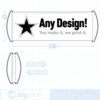Bright colors, lasting prints, and unique designs are very important. We offer several options for customizing a wide range of products— from sportswear, to display items, to commercial jobs and handouts. Our west-coast shop houses an efficient array of equipment for producing several kinds of printed items. These capabilities allow us to produce both low-quantity and high-volume jobs with accuracy and speed. And in-house color matching ensures that your completed job remains true to the original inputs. The following processes represent an overview of our capabilities. Each of them offer unique advantages, and when matched with appropriate surfaces, will last many years at maximum vibrancy.
Vapor Printing
Also known as “dye sublimation” or “thermal dye”, Vapor printing is a digital print process that uses heat to “vaporize” a liquid ink and dye the printed surface. It is commonly used for sportswear, apparel, and many types of hard surfaces— including handouts, awards, and professional photography displays. Because the ink turns into gas and deeply permeates the printed item, vapor printing is an extremely high quality, durable option. But not all garments and hard surfaces should be vapor-printed. Not every surface and garment can permanently absorb the vaporized ink, so give us a call if you’d like assistance matching a proper print process to your desired job.
Fusion Printing
When a garment or fabric cannot fully absorb the gassed inks produced from Vapor printing, Fusion printing is a perfect option. It is commonly used on canopies, sportswear, and other decorative applications. Much like screen-printing or “silk-screening”, fusion printing binds to the outer-layer of a garment. Unlike screen-printing, fusion printing allows for fast, full color (“photographic-like”) prints that don’t require setup fees for pre-print preparation. This makes Fusion printing ideal for cost-effective, low volume jobs.
Fusion printing begins with a thin film that is matched to a specific type of fabric, depending on desired performance and intended use. This “thermal film” is permanently fused to the surface of a fabric with a precisely-timed application of extreme heat. Solid-color Fusion prints are usually pre-dyed to resist color loss due to prolonged sun exposure and washing. For full-color Fusion printing, the film is printed with a vibrant image prior to being heat-applied to a garment or fabric. The result is a durable decorated item that will resist fading for years with proper care.
Giclée Printing
Specifically used for digital-print reproduction of fine-art and photography, Giclée printing uses archival-quality, solvent-based ink and a paper or canvas specially treated to retain the printed image for extended periods of display and storage. Unlike offset lithography that is a popular choice for reproduction of two-dimensional artwork, Giclée printing does not require a lengthy setup process and, therefore, does not share its associated pre-print cost. This makes low-volume print-runs very cost effective for designers and photographers who do not need hundreds of copies of a single print.



